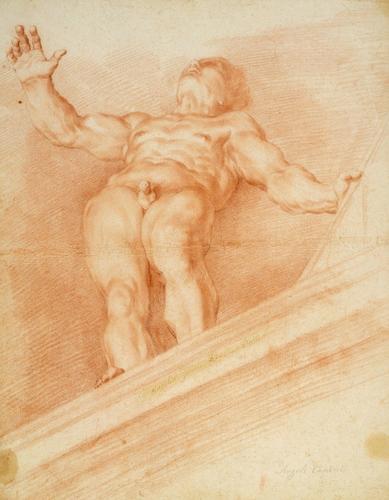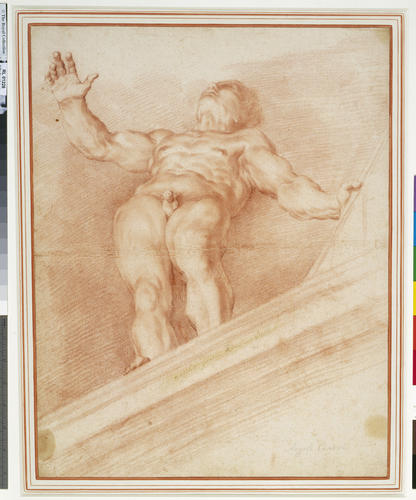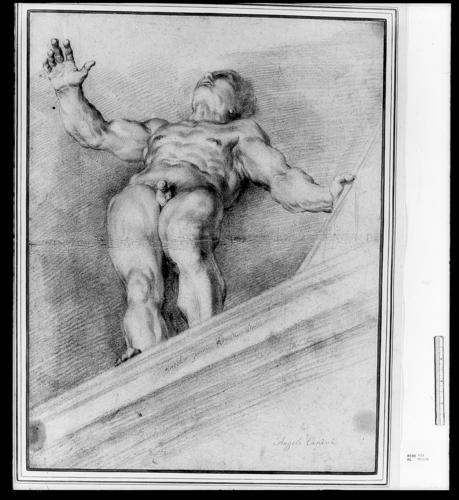A male nude seen from below c. 1660
Red chalk, stumped in places | 51.4 x 39.5 cm (sheet of paper) | RCIN 991228
-
Though he was an undistinguished painter, Canini was a fine draughtsman and his drawings were esteemed in their day, as suggested by the elegant (effaced) inscription of an early collector on this sheet. The figure is seen in daring foreshortening, as if standing on a ledge high above the viewer. This was probably an exercise rather than a study for a painting.
This drawing is one of a number of figure studies inscribed in the same hand with an attribution to Canini. Three of these at Düsseldorf (in black chalk with white heightening on blue paper) bear variants on the inscription Io Angelus Caninius Ping. et delin. (‘Giovanni Angelo Canini painted and drew [it]’), with one of these, adding in Palatio Pont. in Quirinale Colle (‘in the pontifical palace on the Quirinal hill’). Turner related this last drawing to the decoration of the Gallery of Alexander VII (1656-7) in the Palazzo del Quirinale, a project controlled by Pietro da Cortona to which Canini contributed a Sacrifice of Isaac and a portion of the decorative surround, including figures in chiaroscuro. This setting has been destroyed, and there is no way of checking the accuracy of that inscription, but such specific annotations are often correct.
The figure here is drawn in daring foreshortening, as if standing on a ledge high above the viewer, and it is unlikely that it could have formed part of the Quirinale decorations. It may well have been purely a drawing exercise, and indeed the inscription here - unlike those on the Düsseldorf sheets - does not state that the figure was painted. Two other drawings at in the Royal Collection bear an analogous inscription, though they are much weaker in execution and each apparently by a different hand; this would imply that the inscriptions are not Canini’s signatures, but attributions by an early collector. It is probable that all the inscribed sheets came as a group from Canini’s studio, with drawings by pupils and assistants mixed in with those by Canini himself.
Inscribed lower centre, pen and ink, scratched out: Io Angelus Caninius Romanus Delint; and lower right, pencil: Angelo Canini
Catalogue entry adapted from The Art of Italy in the Royal Collection: Renaissance and Baroque, London, 2007Provenance
Probably acquired by George III in 1762 as part of the collection of Cardinal Alessandro Albani: first recorded in a Royal Collection inventory of c.1810 (Inv. A, p. 106: 'Academie di Diversi Autori...Benedetto Luti, and Angelo Canini')
-
Creator(s)
Acquirer(s)
-
Medium and techniques
Red chalk, stumped in places
Measurements
51.4 x 39.5 cm (sheet of paper)
Object type(s)











